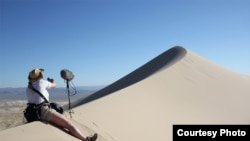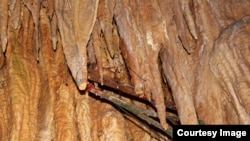Our planet is speaking to us, if we would just stop and listen, says Trevor Cox, an acoustic engineer at the University of Salford in England and author of The Sound Book: The Science of the Sonic Wonders of the World.
A companion website offers sonic gems that resonate far beyond the pages of the book.
Cox records an organ made from cave formations in Luray Caverns in Virginia that plays Chopin, a listening wall in Grand Central Station in New York, and the honk of a bittern, one of the shyist creatures in the freshwater wetlands, but certainly among the loudest.
“I imagined that it would be fairly easy to find lots of interesting places to listen to, but actually, we’re a quite visually dominated society," Cox said. "So it’s easy to find descriptions of beautiful views, but much harder to find descriptions of beautiful sounds.”
With help from sound artists, acoustic engineers and social media, Cox pieced together an itinerary to listen and record. One fork in the road led him to an abandoned tunneled network of World War II oil storage tanks buried in a Scottish hillside.
“And it is the most incredible space, because if I were to go in there and just sing a note, the notes would linger there 30 seconds, a minute," he said. "The sound goes on in that space for an incredibly long time.”
The music bounces off the walls; the location became the test site for the world's longest echo, a gunshot that reverberated for two minutes.
Cox also takes us to pyramids in Guatemala that were built as tombs and shrines to please the gods. He finds a sonic gem hidden in its design that mimics a bird when you clap your hands as you descend the steps.
“Well, it sort of goes choo, choo, choo, a chirping sound," he said.
But how? Cox chalks it up to geometry.
"If you work out how long it takes sound to go from your hands to each tread of the stair and back again, you find that actually this frequency drops as the sound comes back to you, so the echo kind of droops down in frequency.”
Cox found a natural sonic wonder in California’s Mohave Desert. Singing sand dunes are rare but, he says, the ancient Chinese, Charles Darwin and Marco Polo all wrote about them. The hum is caused by an avalanche of sand grains pushed by the wind.
“Unfortunately the wind wasn’t moving the sound when I was there. So, I had to create my own avalanche," he said. "So you sit down on your backside and scoot down the hill and create an avalanche and you get this amazing droning sound, which not only can you hear it, but it kind of vibrates your whole body as well.”
And, not far away, also in California, Cox drove over a stretch of road that plays a well-known tune, very out of tune. He explains that a car company designed the road with grooves deliberately placed in the pavement, so they play a melody as tires roll over them.
“And if the grooves are spaced far apart, you get the low notes. And if the grooves are spaced close together, you get high notes," he said. "And by having different patches of grooves spaced at different distances, you can get different notes out. And that just worked out, how to get the patches in a line, to give you the William Tell Overture.”
Cox says you don’t really have to go anywhere exotic to hear remarkable sounds. He suggests we unplug from our music players to hear the wonders around us.
“It can be as simple as that, just sort of being in silence a bit and listening around for some of your day is enough to suddenly notice that there’s all these sounds that you normally just ignore, and some of them are great.”
A companion website offers sonic gems that resonate far beyond the pages of the book.
Cox records an organ made from cave formations in Luray Caverns in Virginia that plays Chopin, a listening wall in Grand Central Station in New York, and the honk of a bittern, one of the shyist creatures in the freshwater wetlands, but certainly among the loudest.
“I imagined that it would be fairly easy to find lots of interesting places to listen to, but actually, we’re a quite visually dominated society," Cox said. "So it’s easy to find descriptions of beautiful views, but much harder to find descriptions of beautiful sounds.”
With help from sound artists, acoustic engineers and social media, Cox pieced together an itinerary to listen and record. One fork in the road led him to an abandoned tunneled network of World War II oil storage tanks buried in a Scottish hillside.
“And it is the most incredible space, because if I were to go in there and just sing a note, the notes would linger there 30 seconds, a minute," he said. "The sound goes on in that space for an incredibly long time.”
The music bounces off the walls; the location became the test site for the world's longest echo, a gunshot that reverberated for two minutes.
Cox also takes us to pyramids in Guatemala that were built as tombs and shrines to please the gods. He finds a sonic gem hidden in its design that mimics a bird when you clap your hands as you descend the steps.
“Well, it sort of goes choo, choo, choo, a chirping sound," he said.
But how? Cox chalks it up to geometry.
"If you work out how long it takes sound to go from your hands to each tread of the stair and back again, you find that actually this frequency drops as the sound comes back to you, so the echo kind of droops down in frequency.”
Cox found a natural sonic wonder in California’s Mohave Desert. Singing sand dunes are rare but, he says, the ancient Chinese, Charles Darwin and Marco Polo all wrote about them. The hum is caused by an avalanche of sand grains pushed by the wind.
“Unfortunately the wind wasn’t moving the sound when I was there. So, I had to create my own avalanche," he said. "So you sit down on your backside and scoot down the hill and create an avalanche and you get this amazing droning sound, which not only can you hear it, but it kind of vibrates your whole body as well.”
And, not far away, also in California, Cox drove over a stretch of road that plays a well-known tune, very out of tune. He explains that a car company designed the road with grooves deliberately placed in the pavement, so they play a melody as tires roll over them.
“And if the grooves are spaced far apart, you get the low notes. And if the grooves are spaced close together, you get high notes," he said. "And by having different patches of grooves spaced at different distances, you can get different notes out. And that just worked out, how to get the patches in a line, to give you the William Tell Overture.”
Cox says you don’t really have to go anywhere exotic to hear remarkable sounds. He suggests we unplug from our music players to hear the wonders around us.
“It can be as simple as that, just sort of being in silence a bit and listening around for some of your day is enough to suddenly notice that there’s all these sounds that you normally just ignore, and some of them are great.”








